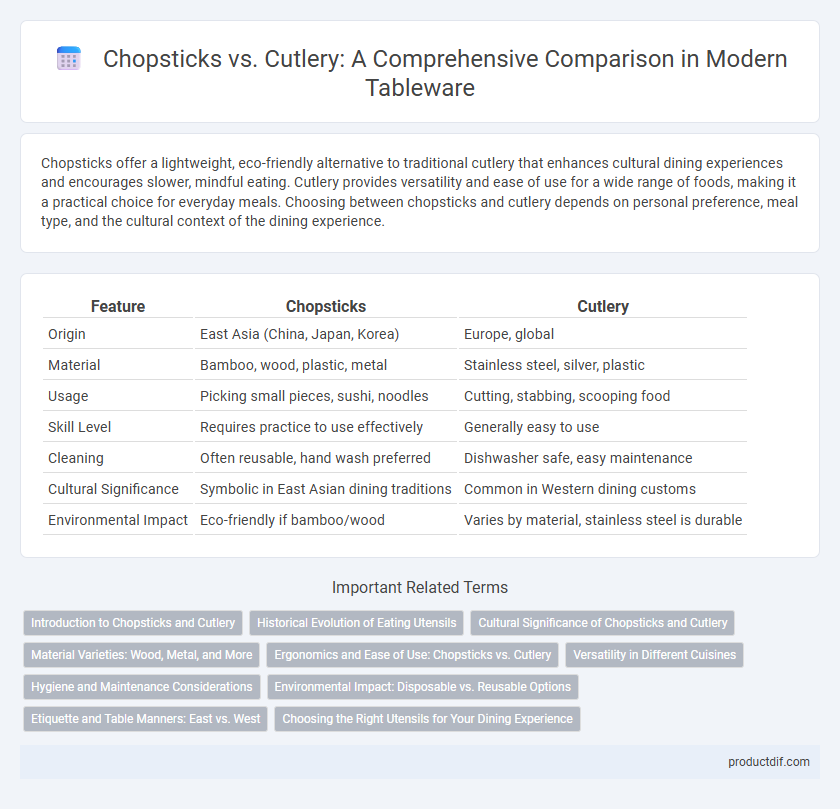Chopsticks offer a lightweight, eco-friendly alternative to traditional cutlery that enhances cultural dining experiences and encourages slower, mindful eating. Cutlery provides versatility and ease of use for a wide range of foods, making it a practical choice for everyday meals. Choosing between chopsticks and cutlery depends on personal preference, meal type, and the cultural context of the dining experience.
Table of Comparison
| Feature | Chopsticks | Cutlery |
|---|---|---|
| Origin | East Asia (China, Japan, Korea) | Europe, global |
| Material | Bamboo, wood, plastic, metal | Stainless steel, silver, plastic |
| Usage | Picking small pieces, sushi, noodles | Cutting, stabbing, scooping food |
| Skill Level | Requires practice to use effectively | Generally easy to use |
| Cleaning | Often reusable, hand wash preferred | Dishwasher safe, easy maintenance |
| Cultural Significance | Symbolic in East Asian dining traditions | Common in Western dining customs |
| Environmental Impact | Eco-friendly if bamboo/wood | Varies by material, stainless steel is durable |
Introduction to Chopsticks and Cutlery
Chopsticks, traditional utensils in East Asian cultures, consist of two slender sticks used for picking up food, often crafted from materials like bamboo, wood, or metal. Cutlery, commonly used in Western dining, includes forks, knives, and spoons designed for cutting, spearing, and scooping food efficiently. Understanding the distinct designs and cultural significance of chopsticks and cutlery enhances appreciation of global dining practices and tableware functionality.
Historical Evolution of Eating Utensils
Chopsticks, dating back over 5,000 years to ancient China, evolved as slender, reusable utensils ideal for picking up bite-sized pieces of food, reflecting Eastern culinary practices and cultural values emphasizing sharing and communal dining. Western cutlery, including forks, knives, and spoons, developed later during the Roman Empire and Middle Ages, driven by the need to manage roasted meats and complicated dishes, symbolizing individual dining and refinement. The historical evolution of eating utensils showcases distinct cultural adaptations and technological advancements shaped by geography, cuisine, and social customs.
Cultural Significance of Chopsticks and Cutlery
Chopsticks hold profound cultural significance in East Asian societies, symbolizing respect, tradition, and social etiquette, often linked to rituals and ceremonies. Cutlery, including forks, knives, and spoons, reflects Western dining customs emphasizing practicality, precision, and social status, with variations across European cultures highlighting historical influences. Both utensils embody their respective cultural identities and eating philosophies, shaping dining experiences and etiquette worldwide.
Material Varieties: Wood, Metal, and More
Chopsticks and cutlery come in diverse material varieties, including wood, metal, bamboo, plastic, and stainless steel, each offering unique durability and aesthetic appeal. Wooden chopsticks provide a lightweight, biodegradable option favored in Asian cultures, while metal cutlery--such as stainless steel forks and knives--offers long-lasting strength and easy maintenance. Specialty materials like titanium and carbon fiber are emerging for both chopsticks and cutlery, combining modern design with enhanced functionality.
Ergonomics and Ease of Use: Chopsticks vs. Cutlery
Chopsticks offer precise control and promote finger dexterity, making them ergonomically suitable for picking small or delicate food items. Cutlery, including forks and knives, provides leverage and stability, enhancing ease of cutting and scooping tasks, especially for those with limited fine motor skills. Ergonomic design in both chopsticks and cutlery aims to minimize hand strain, but cutlery generally requires less specialized technique, offering more universal ease of use.
Versatility in Different Cuisines
Chopsticks offer exceptional precision for picking up bite-sized pieces in East Asian cuisines, enhancing the dining experience with sushi, dim sum, and noodle dishes. Cutlery, including forks, knives, and spoons, provides versatility suited for Western meals, accommodating a wide range of textures from tender meats to soups and salads. Both utensils reflect cultural dining practices while adapting to various culinary styles worldwide, making them integral to their respective food traditions.
Hygiene and Maintenance Considerations
Chopsticks, often made from bamboo or wood, require thorough drying after washing to prevent bacterial growth and maintain hygiene, while cutlery made from stainless steel is more resistant to corrosion and easier to sterilize. Wooden chopsticks may absorb moisture and food particles, demanding careful cleaning and occasional replacement, whereas metal cutlery can be safely cleaned in high-temperature dishwashers without degrading. Proper maintenance of both ensures long-lasting use, but cutlery generally offers superior hygiene due to its non-porous material and dishwasher compatibility.
Environmental Impact: Disposable vs. Reusable Options
Disposable chopsticks, often made from single-use wood or bamboo, contribute significantly to deforestation and landfill waste, with billions discarded annually. Reusable chopsticks made from sustainable materials like stainless steel or high-quality bamboo reduce environmental footprints by decreasing resource consumption and waste generation over time. In contrast, disposable plastic cutlery generates long-lasting pollution due to slow decomposition, whereas reusable metal or bamboo cutlery supports a circular economy with lower overall ecological impact.
Etiquette and Table Manners: East vs. West
Chopsticks require precise and respectful handling, such as not sticking them upright in a bowl, a gesture associated with funerary rites in many East Asian cultures. In contrast, Western cutlery use emphasizes the proper placement of knives and forks to signal dining progress, with etiquette dictating specific grips and resting positions. Understanding these cultural nuances enhances global dining experiences and shows respect for diverse traditions.
Choosing the Right Utensils for Your Dining Experience
Choosing the right utensils for your dining experience depends on the cuisine and cultural context, with chopsticks being ideal for East Asian dishes like sushi or noodles, offering precision and a traditional touch. Cutlery, including forks, knives, and spoons, suits Western meals that require cutting, scooping, or spreading, enhancing ease and efficiency. Understanding the specific dining style and meal components ensures the selection of utensils complements both functionality and authenticity.
Chopsticks vs Cutlery Infographic

 productdif.com
productdif.com